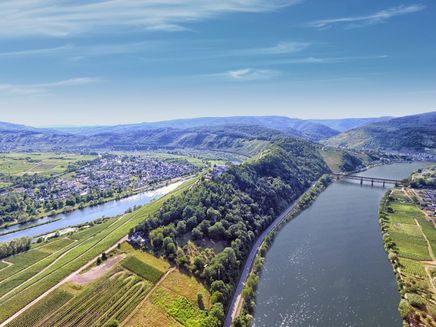- Kastel-Staadt
The grave of the Blind King John of Bohemia is a masterpiece by the famous Prussian architect Schinkel.
High above the valley of the Saar below, at the tip of a protruding sandstone cliff, lies the hermitage of Kastel-Staadt, providing fascinating insights and views. At the time of the crusades, caves, rooms and alcoves were dug in the soft, coloured sandstone, symbols of the myth of the discovery of the cross. In one cave room a “Holy Grave” was dug, in addition to living rooms and prayer rooms, which were supposed to resemble the sacred sites on the mountain in Golgotha in Jerusalem. In the Middle Ages religious hermits lived here. Construction of the hermitage chapel began in essence around 1600. On top of its predecessors, a Franciscan father created a two-storey building which at ground level contained a church interior and above that a residence for the hermits. Until the French Revolution, hermits lived and prayed here, after which the building fell into disrepair, until the Prussian king Friedrich Wilhelm had the long-abandoned ruins of the hermitage expanded into a mausoleum for the Bohemian King John of Luxembourg.
In 1833, during a visit to the Rhineland, Friedrich Wilhelm received the mortal remains of King John of Bohemia, whose life story fascinated him. Despite being blinded, John of Luxembourg was drawn upon as an ally of France against the English troops in the battle of Crécy, in which he fell in August 1346. The victor, Edward III of England, allowed the fallen blind king to be interred with full honours in the Benedictine Abbey in the city of Luxembourg. As a result of the destruction of his tomb, the remains ultimately fell into the hands of the Prussians. Friederich Wilhelm, who admired the blind king for his bravery, had the hermitage developed into his final resting place. Friedrich Wilhelm commissioned the architect Karl Friedrich Schinkel, the head of the highest building authority, to rebuild the hermitage. Schinkel designed the building in the style of Mediterranean-influenced romanticism, with arched windows, colonnades and a bell gable in the Italian style. The interior of the ground floor was left unchanged, however. The remains of the Bohemian king rested in the hermitage from 1838 to 1946 when they were transferred to the cathedral in Luxembourg.
On the map
König-Johann-Straße
54441 Kastel-Staadt
DE
Phone: 0049 6581 995980
Mobile: 0049 152 32717805
E-mail: info@saar-obermosel.de
Website: www.saar-obermosel.de
General information
Openings
16.04.-31.10.2025: Wednesday to Sunday 10 AM - 4 PM, July and August 10 AM - 5 PM. Last admission is one hour before closing. Open on public holidays in Rhineland-Palatinate. Please note that the cloister may be closed at short notice due to weather conditions for your own safety.
Admission:
4.00 € Adults, 3.00 € Students over 16 years, Students, Apprentices, Pensioners, Unemployed, Severely disabled – each with proof, 2.00 € Children and teenagers aged 7-16 years, Children up to 6 years free
Dayoff
Monday,Tuesday





